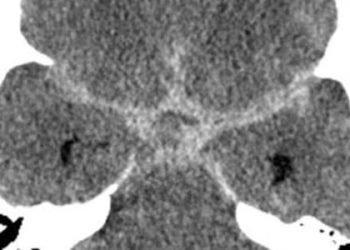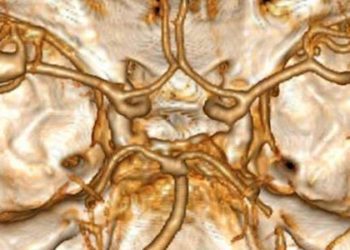Endovascular coiling provides lasting benefits for brain aneurysms
1. Ten years after patients received endovascular coiling (EC) or neurosurgical clipping (NC) for a subarachnoid hemorrhage, EC patients were more likely to be alive and independent that NC patients.
EC patients were at higher risk to experience re-bleeding from the target aneurysm, though there was no significant difference in risk of death or dependency as a result of re-bleeding between EC and NC patients.
Evidence Rating Level: 1 (Excellent)
Study Rundown: A subarachnoid hemorrhage is often the result of a ruptured brain aneurysm, which is the bulging of a weak spot in the wall of a brain blood vessel. Immediate treatment of the aneurysm is required to stabilize the patient and stop bleeding into the brain. The most common treatment procedure prior to 2000 was NC, in which a hole is drilled in the skull to allow access to the aneurysm, and small clip is surgically placed to stop the bleeding. This invasive procedure has now been largely replaced by EC, in which a small spring-like coil is guided by a set of catheters initiating at the femoral artery into the brain aneurysm. The coil is believed to prevent pressure buildup and further bleeding from the aneurysm. As recently as 2011, 85% of ruptured aneurysm patients were treated with EC.
This large, prospective study began in 1994, when EC was just beginning to gain popularity, and investigates the long-term outcomes of EC and NC patient cohorts. Researchers found that 10 years after initial procedures EC patients had an increased likelihood of being alive and independent (patient reported) than the NC patients. While EC patients required more follow-up treatments (reported previously), and more re-bleeding from the treated aneurysm, no difference in risk of death or dependency as a result of the re-bleeding were found between the EC and NC patient groups. The large majority of long-term deaths in this study were unrelated to brain aneurysms, suggesting detailed follow up of EC or NC patients may be unnecessary. This study may not accurately capture the effectiveness of the EC procedure, as it has been refined since the early nineties.
Click to read the study in the Lancet
Click to read an accompanying editorial in the Lancet
In-Depth [randomized controlled trial]: This study reports on the long-term (between 10 and 18.5 years) outcomes of patients with subarachnoid hemorrhage who were randomly assigned to immediately receive either EC or NC. Of the initial 2143 patients from 43 United Kingdom medical centers enrolled in the trial, 1003 returned questionnaires at 10 years. Patients were assessed for rates of death, dependence (as measured by patient-reported Rankin scale [mRS] scores), and recurrent bleeding from the original or a new aneurysm.
From the patient reports collected at 10 years, researchers determined there was no difference in the proportion of patients reporting strong independence (mRS score 0-2) between the EC and NC groups. However, the EC patients did have a significantly greater probability of independent survival than NC patients (EC = 0.682 versus NC 0.617, odds ratio 1.34 [1.07-1.67 95% CI]). Of the six deaths resulting from recurrent bleeding from the target aneurysm after one year, 67% were in the EC patient group.
More from this author: Deep brain stimulation linked to declining brain function in Parkinson’s patients, Donor and recipient regulatory T-cells may promote transplant tolerance in mice, Growth factor embedded film promotes robust bone repair, The 3C Study: Alemtuzumab may reduce acute rejection following kidney transplant, Paclitaxel-coated balloons may decrease bronchial stenosis in lung transplants
Image: PD
©2012-2014 2minutemedicine.com. All rights reserved. No works may be reproduced without expressed written consent from 2minutemedicine.com. Disclaimer: We present factual information directly from peer reviewed medical journals. No post should be construed as medical advice and is not intended as such by the authors, editors, staff or by 2minutemedicine.com. PLEASE SEE A HEALTHCARE PROVIDER IN YOUR AREA IF YOU SEEK MEDICAL ADVICE OF ANY SORT.


![The ABCD2 score: Risk of stroke after Transient Ischemic Attack (TIA) [Classics Series]](https://www.2minutemedicine.com/wp-content/uploads/2013/05/web-cover-classics-with-logo-medicine-BW-small-jpg-350x250.jpg)




